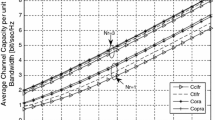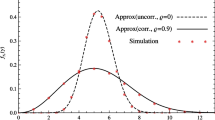Abstract
Due to the crowded orbits and shortage of frequency resources, the use of MIMO technology to improve spectrum efficiency and an increase of the capacity have become a necessary trend of broadband satellite communication. Firstly, we analyze the main influenced factors and compare the bit error rate (BER) performance of space-time block code (STBC) scheme and space-time trellis code (STTC) scheme. Then we build up the model of land mobile satellite (LMS) channel under different environments by using 3-state Markov chain. This paper emphatically studies the BER performance of STTC and STBC in the MIMO satellite channel. The main emphasis is placed on the effects of different factors, such as terminal environment and elevation angles, on the BER performance of STBC and STTC schemes. Simulation results indicate that performance of STTC in Rayleigh channel is obviously improved with the increasing number of transmitting and receiving antennas, but the encoder state has little impact on the performance. In the Rayleigh channel, the performance of Alamouti code is better than that of STTC. In the LMS channel, performance of these two kinds of space-time coding in open area is optimal, and in the urban area it is the worst. Nevertheless, performance of STTC is slightly superior to the performance of STBC under different circumstances. Under the same environmental conditions, BER of STBC and STTC reduces with the increase of the satellite altitude angle, and therefore, the BER curves of STTC fall faster.
Similar content being viewed by others
References
I. E. Telatar, “Capacity of multi-antenna Gaussian channels,” European Trans. Telecom. 10, No. 6, 585 (1999). DOI: 10.1002/ett.4460100604.
Chun Loo, “A statistical model for a land mobile satellite link,” IEEE Trans. Vehicular Technol. 34, No. 3, 122 (Aug. 1985). DOI: 10.1109/T-VT.1985.24048.
F. P. Fontan, M. Vazquez-Castro, C. E. Cabado, J. P. Garcia, E. Kubista, “Statistical modeling of the LMS channel,” IEEE Trans. Vehicular Technol. 50, No. 6, 1549 (Nov. 2001). DOI: 10.1109/25.966585.
David Gesbert, Mansoor Shafi, Da-shan Shiu, P. J. Smith, A. Naguib, “From theory to practice: An overview of MIMO space-time coded wireless systems,” IEEE J. Sel. Areas Commun. 21, No. 3, 281 (Apr. 2003). DOI: 10.1109/JSAC.2003.809458.
Gerard J. Foschini, “Layered space-time architecture for wireless communication in fading environment when using multi-element antennas,” Bell Labs Tech. J. 1, No. 2, 41 (1996). DOI: 10.1002/bltj.2015.
Li Yongzhao, Liao Guisheng, Wang Feng, “Improved BLAST for wireless communications,” J. Systems Engineering Electronics 17, No. 1, 48 (Mar. 2006). DOI: 10.1016/S1004-4132(06)60009-1.
S. M. Alamouti, “A simple transmit diversity technique for wireless communications,” IEEE J. Sel. Areas Commun. 16, No. 8, 1451 (Oct. 1998). DOI: 10.1109/49.730453.
V. Tarokh, H. Jafarkhani, A. R. Calderbank, “Space-time block coding for wireless communications: performance results,” IEEE J. Sel. Areas Commun. 17, No. 3, 451 (Mar. 1999). DOI: 10.1109/49.753730.
V. Tarokh, N. Seshadri, A. R. Calderbank, “Space-time codes for high date rate wireless communication: Performance criterion and code construction,” IEEE Trans. Inf. Theory 44, No. 2, 744 (Mar. 1998). DOI: 10.1109/18.661517.
M. Tolga, Ali Ghrayeb, Coding for MIMO Communication System (John Wiley & Sons Ltd, England, 2007).
Xiangbin Yu, Guangguo Bi, “Power control scheme for multiple antenna systems with space-time coding in Rayleigh fading channels,” J. Systems Engineering Electronics 22, No. 5, 730 (Oct. 2011). DOI: 10.3969/j.issn. 1004-4132.2011.05.002.
Peter R. King, Stavros Stavrou, “Characteristics of the land mobile satellite MIMO channel,” Proc. of IEEE Conf. on Vehicular Technology, 25–28 Sept. 2006, Montreal, Que (IEEE, 2006), pp. 1–4. DOI: 10.1109/ VTCF.2006.37.
Yong Soo Cho, Jaekwon Kim, Won Young Yang, Chung G. Kang, MIMO-OFDM Wireless Communications with Matlab (John Wiley & Sons Ltd, Singapore–England, 2010).
F. P. Fontán, J. P. González, M. J. S. Ferreiro, M. A. V. Castro, S. Buonomo, J. P. Baptista, “Complex envelope three-state Markov model based simulator for the narrow-band LMS channel,” Int. J. Satellite Commun. Networking 15, No. 1, 1 (Jan. 1997). DOI: 10.1002/(SICI)1099-1247(199701)15:1<1::AID-SAT563> 3.0.CO;2-R.
Author information
Authors and Affiliations
Corresponding author
Additional information
Original Russian Text © Q. Jing, J. Wu, 2017, published in Izvestiya Vysshikh Uchebnykh Zavedenii, Radioelektronika, 2017, Vol. 60, No. 1, pp. 3–17.
This work was supported by the National Science Foundation of China (61301105).
About this article
Cite this article
Jing, Q., Wu, J. Performance comparison of space-time block and trellis codes in the MIMO land mobile satellite channels. Radioelectron.Commun.Syst. 60, 1–12 (2017). https://doi.org/10.3103/S0735272717010010
Revised:
Published:
Issue Date:
DOI: https://doi.org/10.3103/S0735272717010010




